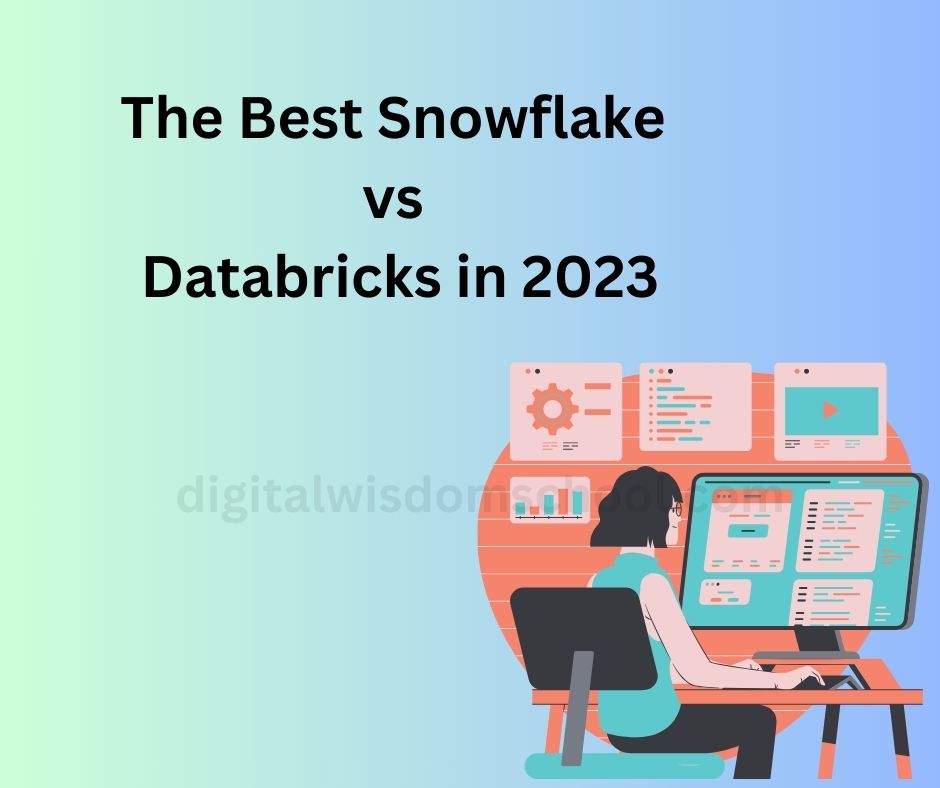snowflake vs databricks
Snowflake and Databricks are two different technologies with different goals in the data management and analytics arena. There are some important reason in between snowflake vs databricks Let’s explore each of them:
- Snowflake:
Type: Snowflake is a cloud-based data warehousing platform.
Purpose: It is designed for storing and analyzing large volumes of data in a scalable and cost-effective manner.
- Architecture: Snowflake uses a multi-cluster, shared data architecture, separating storage and compute resources. This allows for on-demand scaling of compute resources and efficient data sharing of Snowflake vs Databricks.
- Query Language: Snowflake uses SQL as its query language, making it familiar to many analysts and data professionals. Concurrency: It supports a high level of concurrency, allowing multiple users to run queries simultaneously without significant performance degradation.
- Integration: Snowflake integrates with various BI (Business Intelligence) tools and has connectors for popular data integration platforms.
- Databricks:
- Type:
- Databricks is a unified analytics platform built on top of Apache Spark.
- Purpose: It provides a collaborative environment for big data analytics and machine learning. It’s often used for data engineering, data science, and machine learning tasks.
- Architecture: Databricks leverages Apache Spark for distributed data processing. It offers a notebook-based interface for writing code (in languages like Python, Scala, SQL, and R) and supports various data processing workloads.
- Collaboration:
- Databricks is designed to facilitate collaboration between data engineers, data scientists, and analysts. It supports version control and allows teams to work on shared notebooks.
- Machine Learning:
- Databricks includes features for building and deploying machine learning models.Supports popular ML frameworks such as TensorFlow, PyTorch, and scikit-learn.
- Integration:
- Databricks integrates with various data sources, and it supports connectivity with different storage systems, databases, and streaming platforms.
In summary, Snowflake is primarily focused on cloud-based data warehousing and analytics, while Databricks is more oriented towards unified analytics and collaborative data science, leveraging the power of Apache Spark, which one you choose depends on your use case and needs In some scenarios, organizations might even use both in conjunction to address different aspects of their data management and analytics needs like a snowflake vs databricks.
What is better Data bricks or Snowflake?
The choice between Databricks and Snowflake depends on your specific use case, requirements, and the nature of your data-related tasks. Both Databricks and Snowflake are powerful tools, but they serve different purposes in the data ecosystemHere are some factors that will help you choose between the two
Choose Databricks if:
- Unified Analytics Platform:
- You need a platform that unifies data engineering, data science, and machine learning in a collaborative environment.
- Big Data Processing:
- Your primary focus is on distributed data processing, and you want to leverage the capabilities of Apache Spark for tasks such as ETL (Extract, Transform, Load) and data analysis.
- Machine Learning and Data Science:
- You have a strong emphasis on building and deploying machine learning models, and you want a platform that supports popular ML frameworks.
- Collaboration:
- Your team requires a collaborative workspace with version control features for sharing and iterating on code and analyses.
Choose Snowflake if:
- Data Warehousing:
- Your main goal is cloud-based data warehousing, where you need a scalable and cost-effective solution for storing and analyzing large volumes of structured and semi-structured data.
- Scalability and Concurrency:
- You require a data platform that can scale both storage and compute resources independently and handle high levels of concurrency in a multi-user environment.
- SQL-Based Analytics:
- Your team is more comfortable with SQL for analytics, and you want a platform that supports standard SQL queries for data analysis.
- Data Sharing:
- You need to easily share and collaborate on data with external parties, as Snowflake has features that facilitate secure data sharing between different organizations.
Considerations for Both:
- Integration:
- Evaluate how well each platform integrates with your existing data ecosystem, including data sources, BI tools, and other platforms.
- Cost:
- Compare the pricing models of Snowflake vs Databricks to ensure that they align with your budget and usage patterns.
- Scalability:
- Consider the scalability requirements of your workload and how each platform handles the scaling of resources.
- Security and Compliance:
- Assess the security features and compliance standards supported by each platform to ensure they meet your organization’s requirements.
Ultimately, the “better” choice depends on your specific needs and the characteristics of your data workloads. Some organizations may find that using both Snowflake vs Databricks in conjunction is the most effective way to address different aspects of their data management and analytics
Why Snowflake is better than Spark?
It’s important to note that Snowflake and Apache Spark are not directly comparable, as they serve different purposes in the data ecosystem. Snowflake is a cloud-based data warehousing platform, while Apache Spark is a distributed data processing framework. Each has its strengths and use cases. That being said, here are some scenarios where Snowflake might be preferred over Spark:
- Ease of Use:
- Snowflake:
- It provides a fully managed cloud data warehousing service, which means users don’t have to manage the infrastructure, tuning, or optimization. Snowflake abstracts away many of the complexities associated with traditional data warehousing.
- Spark:
- While powerful, Spark often requires more manual tuning and optimization, and users may need to manage clusters and resources themselves.
- Scalability:
- Snowflake:
- Offers automatic scaling of both storage and compute resources. Users can scale their data warehouse up or down based on demand without significant manual intervention.
- Spark:
- Users need to manage cluster sizes and configurations, which may require more manual effort for scaling.
- Concurrent Access and Workload Isolation:
- Snowflake:
- Designed to handle high levels of concurrency with a multi-cluster, shared data architecture. It provides good workload isolation, allowing multiple users to run queries simultaneously without impacting each other.
- Spark:
- While it supports parallel processing, managing concurrency and workload isolation can be more complex, and users might need to fine-tune their Spark configurations for optimal performance.
- Data Sharing and Collaboration:
- Snowflake:
- Facilitates easy and secure data sharing between different organizations, making it suitable for collaborative projects involving multiple parties.
- Spark:
- While it can be used collaboratively, it may require more manual effort to set up and manage data sharing between different instances of Spark clusters.
- SQL Integration:
- Snowflake:
- Uses SQL as its query language, making it familiar to many analysts and data professionals who are already accustomed to SQL for data analysis.
- Spark:
- Supports multiple programming languages (Scala, Python, Java, and R), which can be powerful for developers but may require a steeper learning curve for analysts primarily using SQL.
In summary, Snowflake is often preferred in scenarios where the focus is on cloud-based data warehousing, simplicity, and ease of use. Spark, on the other hand, is a powerful tool for distributed data processing, especially in scenarios where fine-grained control over data processing and machine learning tasks is required. The choice between them depends on the specific requirements of your data workloads.
Why we chose Data bricks over Snowflake?
The decision to choose Snowflake vs Databricks (or vice versa) depends on your specific use case, requirements, and the nature of your data-related tasks. Below are some reasons why an organization might choose Snowflake vs Databricks :
- Unified Analytics Platform:
- Databricks:
- If your organization needs a unified platform for analytics, data engineering, and machine learning, Databricks provides an integrated environment for these tasks. It allows data professionals to work collaboratively in a single platform, leveraging Apache Spark for distributed data processing.
- Snowflake:
- While Snowflake is excellent for cloud-based data warehousing and analytics, it’s more focused on SQL-based analytics and may not offer the same level of integration for data science and machine learning tasks.
- Machine Learning and Data Science:
- Databricks:
- If your primary focus is on machine learning and data science, Databricks provides a platform that supports the development, training, and deployment of machine learning models. It integrates with popular ML frameworks and provides collaborative tools for data scientists.
- Snowflake:
- While Snowflake has some capabilities for data science and analytics, it’s not as specialized for machine learning tasks as Databricks.
- Apache Spark Ecosystem:
- Databricks:
- If your organization is heavily invested in the Apache Spark ecosystem and prefers using Spark for distributed data processing, Databricks provides a managed and optimized Spark environment. It abstracts away the complexities of managing Spark clusters.
- Snowflake:
- Snowflake is more focused on cloud data warehousing and SQL-based analytics. While it supports parallel processing, it doesn’t provide the same level of control over Spark-specific configurations as Databricks.
- Collaboration and Notebooks:
- Databricks:
- If your team values collaborative work and the use of notebooks for sharing and documenting code, Databricks provides a collaborative workspace with features like version control, making it easier for teams to work together.
- Snowflake:
- While Snowflake supports SQL-based queries, it may not offer the same level of collaboration and notebook-based workflow as Databricks.
- Existing Technology Stack:
- Databricks:
- If your organization is already using other components of the Databricks platform or has a technology stack that aligns well with Databricks, it might be a natural choice to maintain consistency across the data and analytics ecosystem.
- Snowflake:
- If your organization is heavily invested in cloud-based data warehousing and prefers a dedicated solution for scalable analytics, Snowflake may be a better fit.
Ultimately, the choice between Snowflake vs Databricks depends on your organization’s specific needs, existing infrastructure, and the nature of your data workloads. Some organizations may even choose to use both platforms in conjunction to address different aspects of their data management and analytics requirements.
Is this conversation helpful so far?
What is the future of Databricks?
As of my last knowledge update in January 2023, I don’t have real-time information on specific events or developments. The future of Databricks, like any technology company, is subject to various factors, including market trends, competition, technological advancements, and customer adoption. However, I can provide some insights into the trends and areas where Databricks has been focusing, which could influence its future trajectory:
- Unified Data and AI Platform:
- Databricks has been positioning itself as a unified analytics platform that integrates data engineering, data science, and machine learning. The trend towards consolidating these workflows into a single platform could continue to shape Databricks’ development.
- Machine Learning and AI:
- Databricks has placed a strong emphasis on machine learning and artificial intelligence capabilities. The future may see further enhancements and integrations in these areas, possibly with advancements in model development, deployment, and management.
- Open Source Contributions:
- Databricks is closely associated with Apache Spark, an open-source distributed computing system. Continued contributions to the Apache Spark ecosystem and other open-source projects could be part of Databricks’ strategy.
- Cloud-Native Solutions:
- Given the ongoing shift towards cloud computing, Databricks is likely to stay focused on providing cloud-native solutions. Integration with major cloud providers and optimizing performance on cloud platforms could be crucial for its future growth.
- Data Lakehouse Architecture:
- The concept of a “data lakehouse,” which combines elements of data lakes and data warehouses, has gained attention. Databricks has expressed interest in this architecture, and its future developments may align with evolving data storage and processing paradigms.
- Industry Partnerships:
- Databricks has established partnerships with various tech companies and cloud providers. Future collaborations and integrations could play a role in expanding Databricks’ reach and capabilities.
- Community and User Engagement:
- The engagement with the user community and addressing user feedback is crucial for any platform’s success. Databricks’ future may involve continuous efforts to build and support a vibrant user community.
- Market Dynamics:
- The competitive landscape, market demands, and customer needs will significantly influence Databricks’ future. The company’s ability to adapt to evolving trends and stay innovative will be key.
For the latest and most accurate information about the future of Databricks, I recommend checking the company’s official announcements, product roadmap, and industry news for updates after my last knowledge update in January 2023.
Will Databricks beat Snowflake?
Predicting the future success of specific technologies or companies can be challenging, and the competition between Snowflake vs Databricks is dynamic. Both Snowflake vs Databricks operate in the broader data and analytics space, but they have different focuses and strengths.
As of my last knowledge update in January 2023, both Snowflake vs Databricks have been successful in their respective domains. Databricks is known for its unified analytics platform, emphasizing collaboration and data science alongside data engineering, while Snowflake is a cloud-based data warehousing platform with a focus on scalable analytics.
Factors that could influence the competition between Snowflake vs Databricks include:
- Market Trends:
- Changes in market trends, such as shifts in data processing and analytics preferences, could impact the relative success of Snowflake vs Databricks.
- Innovation:
- The ability of each company to innovate, introduce new features, and respond to evolving customer needs is crucial in the technology landscape.
- Customer Adoption:
- The adoption of these platforms by organizations across various industries will play a significant role. The preferences of enterprises in terms of scalability, ease of use, and integration capabilities will influence the competition.
- Partnerships and Ecosystem:
- Collaborations and partnerships with other technology providers, cloud platforms, and third-party tools can enhance the offerings of Snowflake vs Databricks .
- Performance and Scalability:
- The performance and scalability of each platform in handling large and complex data workloads will be a factor, especially as data volumes continue to grow.
- Industry-Specific Requirements:
- The ability to address industry-specific requirements and compliance standards may influence the success of these platforms in different sectors.
It’s worth noting that organizations may choose to use both Snowflake vs Databricks for different aspects of their data processing and analytics needs, as they are not necessarily mutually exclusive.
To stay updated on the competition and the latest developments between Snowflake vs Databricks , it’s recommended to monitor industry news, product updates, and customer testimonials. The success of each platform will depend on how well they adapt to changing market conditions and continue to meet the evolving demands of their user base.
























